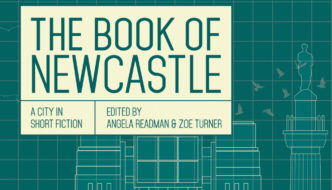
The north is a point on a compass. It’s also a state of mind. It’s both a concept and a place. It’s relative to the south, the east and the west. It’s not to be fetishized or glorified, vilified or stereotyped. It is amongst other things a place where writers live and work and write. I spoke about this to David Steans, fine artist, performer and writer. Because he emerges from the north(ish) and because he has a sensibility that speaks to the ideas that circulate about The North. And because he’s a damn good writer.
How do you regard the north as a concept and as a region?
“The idea of the English North… I like the north! My family are from Manchester. I was born in Stockport, and now live in Leeds, but I grew up in Long Eaton, Nottingham. I wouldn’t be considered a Northerner by a Loiner. Really I’m a Midlander… but there are similarities. Post-industrial. Considered ‘regional’. In the context of the arts, it also means not-London, not-South even.”
Steans says of his practice that “there’s macabre sense of humour at play in much of the work, and the genre of horror is a key reference point.” Horror, with its tenuous yet visceral links to reality, acts as a vehicle for expressing tropes and contradictions around ideas of the North. In his collection of short stories From the Lounge (published by Deptford X, 2018) Steans conjures up local horror in familiar places. In the first story, a librarian is asked where the ‘horror bit’ of the library is. We realise, through short, punchy dialogue, that we the reader are in ‘the horror bit’, that the horror is about to unfold right now in this story collection.
What effect do your Northern sensibilities have on your writing?
“I suppose more generally my writing’s quite English, mainly in terms of its references and style. Often if my writing’s set somewhere specific and recognisable, it’s somewhere in the Midlands or north of England. If it’s a town, it’s Long Eaton. Or somewhere like Darlington. If it’s a city, it’s likely an amalgam of Leeds and somewhere like Derby. Certainly, there is a tone, and sense of humour maybe that partly comes from there. But then, also, it’s made up! I just have places like that in mind.”
Steans says of his writing: “I’m trying to evoke an atmosphere or produce a certain effect rather than convey a specific conceptual meaning. There are concepts there, but it’s that slight difference in intent.”
And what is The North, if not a concept? Coronation Street, flat caps and whippets, short vowels, long winters, chips and gravy, tea not dinner, biting winds. Kestrels. The liminality of the term is itself a place of creative activity. Whether we conjure up the grimness of the streets of Leeds in the 70s or the sparkle and glitter of Harvey Nichols’ shop front – it’s all artifice. The ‘real’ north is ours, yours, and mine. Jostling against and barging into each other’s north. It’s our everyday and our all day; it’s where we are and where we go. When we leave and go elsewhere we leave it behind. But we also take a bit with us. And no one’s is the same. Steans “desire ‘not to hoax, or fake, or trick, but to signal we’re dealing with art here, we’re dealing with artifice basically,” leaves a space for us to make our own north, and hear it with our own ears.
How do feel about the concept of ‘giving voice’ to regions or characters? It’s sometimes positioned as an act of post-colonial power-wielding. Who are we to ‘give’ voice?
“I’m not sure I really do ‘give voice’ in that way. A character might speak a certain way, but it isn’t really intended to be a realistic portrayal, and I think usually that’s clear from the narrative or structure of the piece. In my case, I might ‘give voice’ to a snowman, or a stone, or a spider. Or Penelope Keith. I am not presuming to speak for anyone. But yeah, of course I think it can be that, and conscientious writers would take that on board, or not do it at all if it’s some kind of colonial odiousness.”
Dialogue is particularly effective in Steans’ writing. There’s an uncanny mixture of the prosaic and the whip-smart.
In one story a couple in a high-rise flat are preparing a dinner party for impending guests. One gazes out the window and sees a man lying in the middle of a busy road. Gradually splattered and splayed by the relentless battering of passing cars, one continues to give updates on the man’s progress whilst the other hurries along the food prep:
“- He’s lying down in the road.
– We need another salad I think.
– Mark come and have a look at this. The man’s been run over I think.
– Kim – the salad. They’ll be arriving in half an hour.
– He’ll be in bits soon, Mark. He is in bits.
– They’re here…do you want to let them in.”
Dialogue, or reference to dialogue, is a mixture of the banal and the profound. A horror filmmaker being interviewed says:
“Is there any dialogue in my films? I don’t think so. If there was it wasn’t audible, it was very perfunctory. There definitely was sound. Just no dialogue. The characters didn’t speak.”
Didn’t or couldn’t. But if they do it is rich with meaning. In another story, a family find themselves slowly becoming glued to their own house. In the bath a child shrieks.
“-Mummy the water feels horrible. I can’t move in it, there’s bits in it.
– Just sit still Claire. We’ll get you out in a minute. Your daddy’s coming”.
He isn’t. He’s glued too.
Maybe your spoken performance of your writing has something to say about this idea of voice?
“Well in my spoken performance I use my accent, I speak in what I recognise as my voice, but of course it can become a very self-aware, performed version of that. But then sometimes I adopt other ‘voices’, or sing, or rap, or whatever depending on the work. But then it’s usually recognisable as my voice, or delivery, or accent. It is performed, but not to the extent of acting or mimicry.”
What about the idea of the unreliable narrator and place?
“Narrative and voice recur as subject and feature of my work, and both project a kind of ‘unreliability’. I think I try and use ‘the voice’ as an agent, one that destabilises things a bit. Also, a kind of authorial voice usually manifests in some form, forms ranging from scripted narration to fictional prose, from performative lectures to music. The various voices that crop up, though often attributed to fictional or fictionalised protagonists, bare the traces of me as a subject. It is kind of ventriloquistic, and the idea of being a tourist or ‘visitor’ in/with a voice is echoed by certain motifs that recur in my practice, such as the guide, the tourist, and familiar uncanny proxy humans such as puppets and scarecrows.”
Steans creates fictional places where, as he puts it, there was nothing really there, there was “hardly a set and hardly a costume”. Libraries, a salad bowl, a window, the sight of a crushed limb in a road, a basketball court – these are the essential flickers in the creation of location and character.
Would you write north with a capital N?
“Yes” he replies.
David Steans is an artist working in writing, moving image, performance, music and installation. He is particularly interested in employing the ‘blurring’ of reality and fiction as a creative method. Karen Tobias-Green is a writer and course leader for the BA (hons) Creative Writing degree at Leeds Art University.




Comments